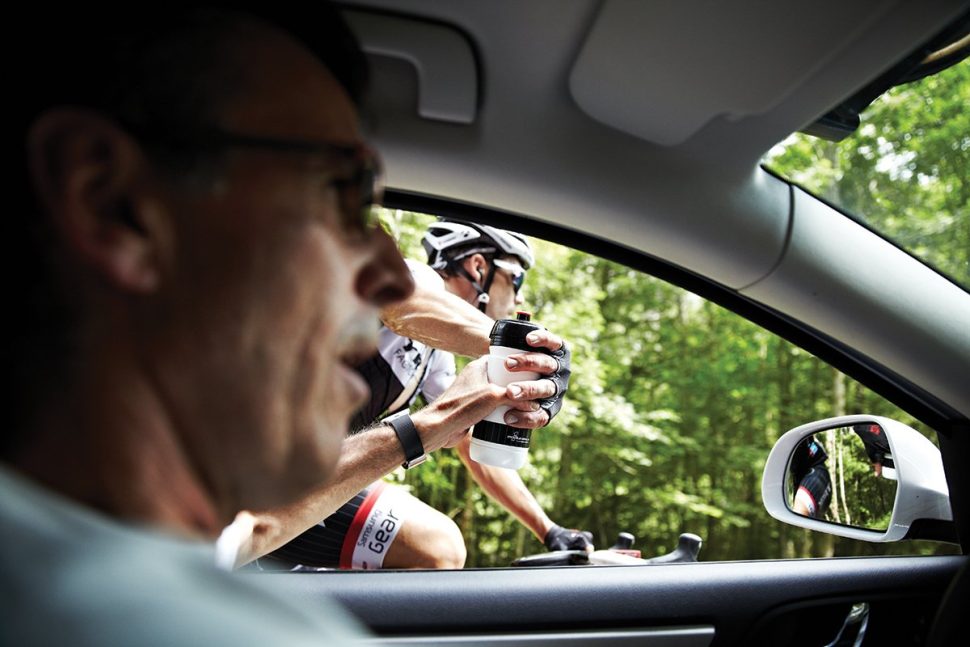Cyclist
How to stop leg cramp when cycling
Cramp. A feeling every cyclist from Tadej Pogačar to your local weekend club rider has experienced. That feeling of your muscles crunching up and stopping you turning the pedals any further. It can be the bane of all our lives.
But why do we experience cramp, and how can it best be combatted – or better still – prevented altogether? Read on as we take a closer look, and reveal the top tips for avoiding this torrid feeling.
What exactly is cramp?
Cramp is sudden spasms that typically last a few painful seconds during which the affected muscle remains tense and unresponsive.
Receptors within muscles and tendons constantly monitor your body’s movement, sending reflexed signals that actually bypass your brain, to protect your muscles from potential damage.
One reflex encourages muscle contraction (to prevent overstretching) while the other promotes relaxation (to control tension).
If these normally balanced reflexes are disrupted, the contraction signal can overwhelm the relaxation one – the result is cramp.
What causes cramp?
The most commonly cited cause is dehydration, but this isn’t strictly accurate. While fluid intake on the bike is vital for many reasons, including as a means of taking on vital electrolytes that do help combat cramp, the root cause is neuromuscular fatigue.
Repetitive use of muscles or muscle groups during exercise causes tiredness, which disrupts the normally efficient neuromuscular pathways which control our muscle movement.
The point at which this starts to happen depends on your fitness level, glycogen and energy stores, as well as external factors such as altitude, temperature and humidity.
How to deal with cramp when cycling

Hydration
Hydration is important, as electrolytes such as sodium and potassium play a key role in facilitating communication between your nerves and your muscles. If you’re insufficiently hydrated you will become tired more quickly – and that means neuromuscular fatigue.
The replacement of electrolytes into the body is no longer considered as important as it once was but it’s still a factor.
So make sure that you drink between one and two bidons an hour depending on the heat and your effort. One bottle should contain water, the other an electrolyte-rich drink.
Strength, conditioning and a proper bike-fit
It also helps to stretch properly both before and during the ride. This will warm up your muscles and increase their range of movement, helping them work more efficiently.
If there is a particular muscle that cramps regularly on the bike, take time pre-ride to limber it up before riding.
Off-the-bike training to build core strength and flexibility can also help so do not neglect high rep, low weight workouts to your legs, core and back to increase muscle endurance.
Als proper bike-fit will ensure your muscles are working at their optimal range and that you’re in the most comfortable riding position your bike can afford.
Acclimatisation
One of the biggest factors can be heat, especially riding in a hotter climate than you are used to, like at a sportive on the continent.
A warmer climate can put your body through heat stress. This, in turn, makes your body sweat a lot quicker, lowering your core temperature and increasing your chances of cramp.
This can be combatted, however. Our bodies are marvellous things and can quite quickly adapt to a new surrounding. With this the case, try to arrive a day or two before an event to allow your body to settle in.
Foods that that can help combat cramp
Nutrition is arguably your biggest ally in the war against cramp. Providing your muscles with sufficient nourishment – and the right kind of nourishment – will enable them to work better, faster and longer, helping to keep the dreaded cramp at bay.
Here are four food types you should focus on as a cyclist:
Potassium-rich foods: A lot of people don’t get enough potassium in their diet and if you find cramps creeping up on you when you ride, this may be the cause.
Potassium is essential – along with sodium – for regulating the electrical signals that can cause your muscles to seize up.
- Get it from… bananas, baked potatoes, sweet potatoes, yoghurt, beans, dates, spinach, and that wonder of nature broccoli.
Sodium-rich foods: When your body sweats to stop it overheating, you excrete not just moisture but salt. Salt (or the sodium in salt) is needed to regulate those cramp-causing mixed signals.
But excessive salt in your diet can acause high blood pressure, so swerve the salted nuts and look instead to get your sodium from wholefoods.
- Get it from… beets, celery, carrots, spinach and chard.
Calcium-rich foods: Low levels of calcium in your body can also lead to muscle cramps and as cycling is a non-impact, endurance exercise that causes you to sweat a lot, you’ll also need to get a lot of this particular mineral into your diet to help maintain healthy bone density, especially as you get older.
- Get it from… natural yoghurt (unsweetened Greek varieties are best), sardines, turnips, dark green leafy vegetables, low-fat cheeses and milk.
Carb-rich foods: Because road cycling is an endurance sport, depletion of your body’s glycogen (its energy stores) is an inevitable consequence.
And as glycogen is mostly stored in your muscles, it figures that the lower those levels are, the more likely you are to suffer cramps.
- Get it from… potatoes, legumes, brown rice, bananas, pasta etc.
The post How to stop leg cramp when cycling appeared first on Cyclist.